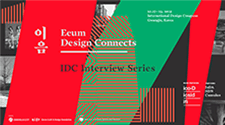Designing as a Catalyst and Connector

21.04.2015 Features
In the third segment of the interview series with key speakers for the 2015 IDC Eeum Design Connects event in Gwangju Korea, Don Ryun Chang, Organizing Chair of the conference interviewed Ahn Sang-soo, founder of Paju Typography Institute (PaTI) and Past Vice President of Icograda from 1997 to 2001, and Torsten Blume, Curator and Art Scientist of the Bauhaus Dessau Foundation.
"In the end, it is about values. What values do we pursue? Do we just want to raise warriors? How should the state and education institutions function?"
- Ahn Sangsoo
Don: I think the biggest issue with design today is change, because of its many different aspects and variables. This is also reflected in change in society, values and the evolving relevance of the design medium. In this context, I would like to ask the both of you how do you see the process of design changing and how does that relate to your current and future agenda for your diverse activities as educators and overseers of design institutions in the case of Ahn, with PaTi, and Torsten, with the Bahaus Dessau Foundation?
Blume: I think that change in design is about the change in the way we talk about and think about design. Forget about design itself. But remember where design came from in terms of the arts. Design is about trying to be useful, functional, and necessary for the society, but in an artistic way. Sources of energy and creativity, capacities of imagination and those powers in imagination are at the center. It leads to different understanding of what design could mean. Much of my practice and ideas stem from the historical Bauhaus; and encouraging people to develop some kind of tenderness about everything and an open mind to other ways of thinking is very general, but integral."
"You can explore many other fields, make connections with other disciplines, and make friends and collaborations. This is somehow like the history of Bauhaus as a school and a workshop; can people try to learn together, redefine themselves and practice together?"
And on designing— design is more practical, maybe sometimes more reflective. It’s about the quality of bringing beauty, poetry, and tenderness to the world. Tenderness in making something we forget about and yet, an awareness of the making. This is what I try to do. Reflect into others in projects and in teaching.
Don: Ahn you have led PaTI for two years, and I believe there has been continued progress during that time. I would like to hear your thoughts on connecting current societal issues with educational institutions, and how this applies to leading your institution.
Ahn: I believe until now as a society we have pursued design that is closely related to our lives, and design that produces stars, or that stands out.
"The most important thing is life, but I have an impression that the gap between life and many things, including design, is widening. Our feet are on the ground, but what we pursue is on much higher ground."
I think a certain lifestyle fits our country or where we live. When our capabilities match with many other things, I think a certain dignity or class is created. If there are gaps, there is a mismatch rather than dignity or class. Even if the phenomenon seems grandiose, it appears ill-fitting. I believe more people are becoming aware of this.
Secondly, I think that power of beauty is greater than power of function.
'We say “form follows function,” but I think it should be “form follows beauty.” But nobody says so. It is unilaterally defined that beauty is decoration. More importantly, the power of beauty calls on our instincts. Function is very rational. The more I think about it, I believe in the power of beauty and that form follows beauty. That’s my honest position.'
Blume: It is important to remember that it is the responsibility of any kind of artists. You can call him a designer, fine artist, or applied artist. This is the responsibility of beauty of form. But what it means by form is very often misunderstood.
"For me, form means a home, an atmosphere, the very things we need. Form is not just a graphic style."
Form defines the “how” and “competence”. If designers or any kind of artists has responsibility of form and people could recognize it, only then you can have multidisciplinary communication with others. The fact you have a face and have character, you have to become a character. You have to have an attitude, expressing this sensitivity and responsibility. Feel responsible for the form and the rest will come. And you will become understandable. But if you try to be a person that knows everything and if designers try to mix just knowledge, it will not work. You have to be honest about your abilities and be responsible to form and atmosphere. It’s a real challenge and it’s going to be hard to be good.
Don: Many young designers and students are going through many stages of confusion right now. We are living in a very complex world with flux of too much information and too many choices. My second question to both of you is related to this. As educators, what do you see as the appropriate structure to provide guidance and inspire them so that they could find their place as designers in the future?
Blume:
"One thing is to trust your senses. Try to be radical in a very pedestrian way. Look on to phenomenon and real effects. There is much information and you have to prove it. What is real information? What makes sense to you and what is the real phenomenon? Look more clearly on how it feels. I think this is the best guidance you can have. Try to taste situations and products as you did as a child."
Ahn: The ultimate purpose is happiness in life. The standards of happiness are all different. We live in an environment, in which many think “you can be happy if you earn a lot of money” or “you need status to be happy.” I think we must escape from such standards.
Don: An important theme for our Congress is multidisciplinary approach, and the title of our Congress is “Design Connects.” With your future endeavors and continuing the legacy of Bauhaus, what do you feel the most appropriate multidisciplinary approach for design will be? How do you want to embed the value of multidisciplinary collaboration in terms of what designers can do in their roles in the society?
Blume:
"Artists and designers from many fields can be active as connectors. They stand out for their desirability of or search for beauty. They can make connections between disciplines because they can create an atmosphere or awareness of atmosphere."
They have the kind of power to connect with people. They have this curiosity and they ask the right questions to the people. They make people aware about situations and atmospheres. They create connectivity between experts and widen the perspective of happiness, beauty, tenderness and poetry by understanding the process, rather than trying to be a half, semi-expert. Professional dilettantism is based on the backbone of connecting things, such as poetry and beauty. There is no limitation.
"Designing a kindergarten, school, railway station, not as a total designer, but as somebody bringing taste to situations, as a catalyst, not ruler. Trying to become a ruler is a wrong attitude. I think that a designer can connect all information."
Read full interview here (scroll down).
For more more information and regular event updates:
Visit the and the Congress website: 2015idc.org
* The views and opinions expressed herein are those of the author and do not necessarily reflect those of ico-D.

relatedarticles

goodbye! and next steps for colleague and friend alexey lazarev

explorations in ethical design: meditations on equality

RCA launches new programme: MA Digital Direction

Interview | Ermolaev Bureau (Moscow)
